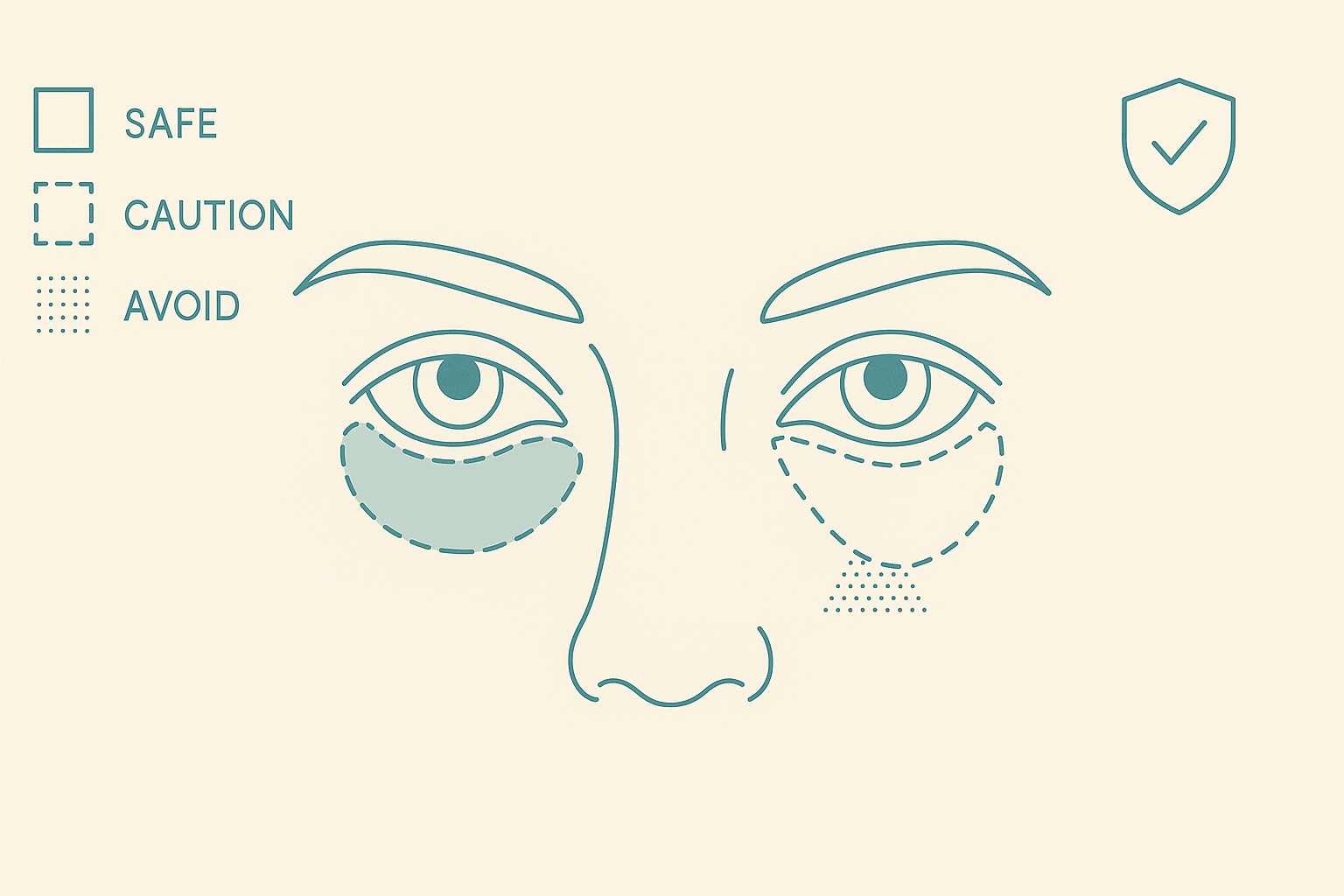Under-Eye (Tear Trough) Filler in 2025: Risks, Brands & Who’s a Good Candidate
Thinking about under-eye (tear trough) filler? This 2025 guide puts safety first. We cover under eye filler risks, trusted tear trough filler brands, and how professionals decide who’s a good candidate. (DE: Tränenrinne Filler Risiken, Unter Augen Filler)
Who is / isn’t a candidate (skin quality, edema, herniation)
Great candidates generally have a true tear trough depression with good skin quality, minimal fluid retention, and realistic expectations. Under-eye filler is usually not ideal if:
- There is significant malaria (under-eye) edema or a tendency to puffiness—filler may worsen swelling.
- There is prominent fat pad herniation (“bags”) where surgical options may be more appropriate.
- Skin is extremely thin with strong blue vessels and pigmentary concerns that filler won’t address.
- Recent infections, active dermatitis, or uncontrolled systemic conditions are present.
- There is a history of adverse events with fillers or allergy to components (e.g., lidocaine).
Professional tip (assessment): In some cases, alternatives like skinboosters, Profhilo, or peri-orbital biostimulating mesotherapy (e.g., Mesoeye C71, Jalupro Young Eye) can improve skin quality and fine creping instead of (or before) structural filler.
Risks (Tyndall, swelling, vascular)
Under-eye filler is delicate because skin is thin and vascular structures are nearby. Key risks include:
- Tyndall effect: a bluish or grey hue if product sits too superficially or if a highly hydrophilic gel attracts water.
- Edema & festoon accentuation: transient swelling is common; chronic puffiness risk rises in predisposed patients.
- Irregularities / visibility: lumps, contour issues, or palpable product if placement or product choice is suboptimal.
- Vascular events: rare but serious. Any sudden pain, blanching, or vision change warrants urgent medical care.
- Infection, biofilm, delayed inflammation: uncommon but possible adverse events.
Risk mitigation relies on case selection, product selection, and experienced technique.
General regulatory and safety context: see EU Medical Devices and EMA. For scientific reading, browse PubMed Central.
Brand characteristics for eyes (soft, low hydrophilicity)
For periorbital work, professionals often select hyaluronic acid (HA) gels with:
- Lower hydrophilicity (less water draw) to reduce puffiness potential.
- Softer rheology (lower G′ / cohesive, moldable) so product integrates under thin skin.
- Consistent cross-linking and purity with CE-mark and reputable manufacturing.
Commonly selected by EU professionals*
- Teosyal Redensity 2 — specialty periorbital HA with soft profile.
- Restylane Eyelight — designed for tear trough indications.
- Belotero Soft or Belotero Balance — used selectively based on case.
- Croma PolyPhil Eye — peri-orbital-oriented portfolio option.
*Final product choice is at the practitioner’s discretion after in-person assessment.
Alternatives & prep for skin quality
These focus on hydration and dermal quality rather than volume replacement.
Technique overview (high level only)
This area is advanced. Experienced injectors tailor the approach based on anatomy, skin thickness, vector of the tear trough, and midface support. At a high level:
- Conservative volumes with staged treatment reduce over-correction risk.
- Depth and plane are chosen to minimize visibility and Tyndall risk.
- Many prefer cannula techniques for reduced trauma; others may use fine needles with careful vectoring.
- Adjunctive midface support may be placed first in suitable cases to improve tear trough indirectly.
Not a DIY treatment: Under-eye filler should only be performed by qualified medical professionals with appropriate training, emergency preparedness, and informed consent processes.
Longevity & maintenance
Periorbital results are typically longer-lasting than dynamic areas like lips, but vary by product, placement, and individual metabolism. Many patients plan reviews within 6–12+ months. Maintenance may include tiny touch-ups or skin-quality boosters rather than full re-volumization.
- Lifestyle: sleep, salt intake, allergies, and fluid balance influence morning puffiness.
- Skin care: gentle moisturizers and antioxidants can support the area post-treatment.
- Follow-up: staged corrections minimize the chance of “overfilled” look.
When to dissolve
If there is persistent swelling, visible product, a Tyndall hue, or contour irregularity that does not settle, professionals may discuss hyaluronidase to dissolve HA filler. This decision weighs risks, allergy history, and goals.
Clinic-use hyaluronidase*
*Prescription-status and usage rules vary by country. For licensed professionals only.
Aftercare support
Post-assessment, professionals may suggest gentle skincare support. Consider:
Cosmetic aftercare does not replace medical evaluation of complications.
Emergency signs: Sudden severe pain, blanching, livedo, or any visual symptoms require urgent medical attention—do not wait.
FAQs
- What causes the Tyndall effect?
- The Tyndall effect appears as a blue/grey tint when HA filler sits too superficially under thin skin or when a very hydrophilic gel draws excess water. Correct depth, conservative volume, and low-hydrophilicity products help prevent it.
- Which brands are known for minimal swelling?
- Professionals often choose softer, less hydrophilic options such as Teosyal Redensity 2 and Restylane Eyelight for this area. Some cases may suit Belotero Soft or Belotero Balance. The “best filler for eyes” depends on anatomy and clinical judgement.
- How quickly does swelling go away?
- Early swelling often settles in days; subtle edema may fluctuate for weeks depending on lifestyle and product. Clinicians favour staged corrections to minimize this.
- Are skinboosters better than filler for fine lines?
- For crepey skin without a deep trough, skinboosters, Profhilo, or formulas like Mesoeye C71 and Jalupro Young Eye can help hydration and texture more than volumizing filler.
- Can under-eye filler be reversed?
- Yes, HA filler can be dissolved by qualified professionals using hyaluronidase (e.g., PR-IME Hyaluronidase, Innoaesthetics Hyaluronidase) after risk-benefit evaluation.

0 comments